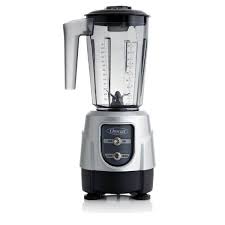Blenders
Blenders

A blender is a kitchen and laboratory appliance used to mix, puree, or emulsify food and other substances. A stationary blender consists of a blender jar with a rotating metal blade at the bottom, powered by an electric motor in the base. Some powerful models can also crush ice. The newer immersion blender configuration has a motor on top connected by a shaft to a rotating blade at the bottom, which can be used with any container.
Heavy Duty Bar Blender
| Capacity (L) | Power | 2L | 1.5Kw | 3.6L | 2.2Kw | 3.9L | 2.8Kw |
|---|---|
COUNTERTOP BLENDERS
Countertop blenders use a 1-2 liters (4-8 cups) blending container made of glass, plastic, stainless steel. Glass blenders are heavier and more stable. Plastic is prone to scratching and absorbing the smell of blended food. Stainless steel is preferred for its looks, but limits visibility of the food as it is blended.
Countertop blenders typically offer 3-16 speed settings, but having more choices in speed settings is not an indication of increased utility for all users.
In cases where the blades are removable, the container should have an o-ring or gasket between the body of the container and the base to seal the container and prevent the contents from leaking. The blending container is generally shaped in a way that encourages material to circulate through the blades, rather than simply spinning around.
The container rests upon a base that contains a motor for turning the blade assembly and has controls on its surface. Most modern blenders offer a number of possible speeds. Low-powered blenders require the addition of some liquid to operate correctly. In these blenders, the liquid helps move the solids around the jar, bringing them in contact with the blades. The blades create a whirlpool effect which moves solids from top to bottom, ensuring even contact with the blade. This creates a homogeneous mixture. High-powered blenders are capable of milling grains and crushing ice without such assistance.
IMMERSION BLENDERS
An immersion blender, or stick blender is a kitchen appliance to blend ingredients or puree food in the container in which they are being prepared. They are sometimes called wand blenders, hand blenders, Bermixers (after the brand name of professional models made by Dito-Electrolux), or boat motors (a nickname for larger commercial-grade immersion blenders, popularized by Emeril Lagasse and Alton Brown). They may be used for pureeing soups and emulsifying sauces. Some can be used while a pan is on the stove. Immersion blenders are distinguished from blenders and food processors that require food be placed in a special vessel for processing. They are distinguished from hand mixers which do not chop the food as it is blended.
MAGIC BULLET / BULLET MIXER
The Magic Bullet is a compact blender manufactured by Homeland Housewares, a division of the American company Alchemy Worldwide, and sold in over 50 countries. It is widely marketed through television advertisements and infomercials and sold in retail stores under the "As seen on TV" banner. A feature-limited retail version not under this banner called the "Magic Bullet Single Shot+" is also available.
Since the introduction of the Magic Bullet, other incarnations include the Magic Bullet To Go, the Bullet Express, the Baby Bullet, the NutriBullet and the Dessert Bullet.
USAGES OF BLENDERS
Learn about Blenders
Understanding Blender Specifications :-


